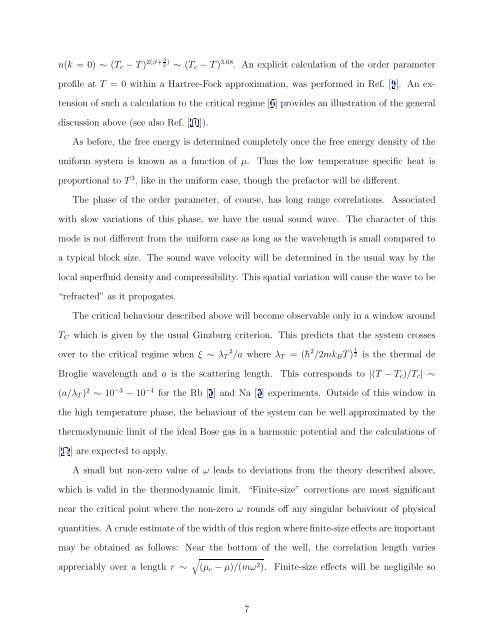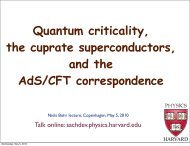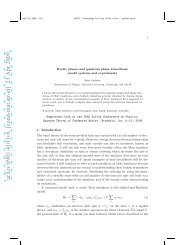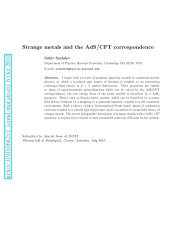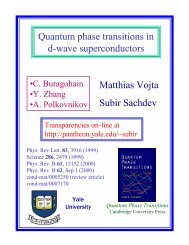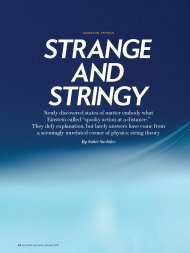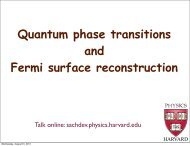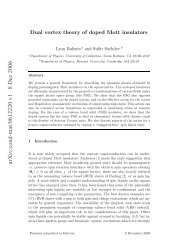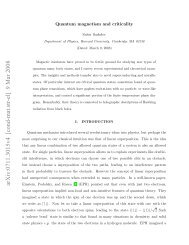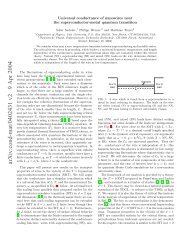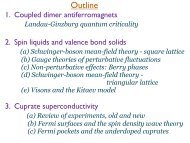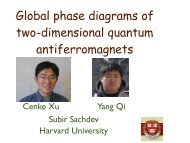Phase transition of a Bose gas in a harmonic potential
Phase transition of a Bose gas in a harmonic potential
Phase transition of a Bose gas in a harmonic potential
You also want an ePaper? Increase the reach of your titles
YUMPU automatically turns print PDFs into web optimized ePapers that Google loves.
n(k =0)∼ (T c − T ) 2(β+ 3 2 ) ∼ (T c − T ) 3.68 . An explicit calculation <strong>of</strong> the order parameterpr<strong>of</strong>ile at T = 0 with<strong>in</strong> a Hartree-Fock approximation, was performed <strong>in</strong> Ref. [9]. An extension<strong>of</strong> such a calculation to the critical regime [6] provides an illustration <strong>of</strong> the generaldiscussion above (see also Ref. [10]).As before, the free energy is determ<strong>in</strong>ed completely once the free energy density <strong>of</strong> theuniform system is known as a function <strong>of</strong> µ.Thus the low temperature specific heat isproportional to T 3 , like <strong>in</strong> the uniform case, though the prefactor will be different.The phase <strong>of</strong> the order parameter, <strong>of</strong> course, has long range correlations. Associatedwith slow variations <strong>of</strong> this phase, we have the usual sound wave. The character <strong>of</strong> thismode is not different from the uniform case as long as the wavelength is small compared toa typical block size. The sound wave velocity will be determ<strong>in</strong>ed <strong>in</strong> the usual way by thelocal superfluid density and compressibility. This spatial variation will cause the wave to be“refracted” as it propogates.The critical behaviour described above will become observable only <strong>in</strong> a w<strong>in</strong>dow aroundT C which is given by the usual G<strong>in</strong>zburg criterion. This predicts that the system crossesover to the critical regime when ξ ∼ λ 2 T /a where λ T =(¯h 2 /2mk B T ) 1 2 is the thermal deBroglie wavelength and a is the scatter<strong>in</strong>g length. This corresponds to |(T − T c )/T c |∼(a/λ T ) 2 ∼ 10 −3 − 10 −4 for the Rb [1] and Na [3] experiments. Outside <strong>of</strong> this w<strong>in</strong>dow <strong>in</strong>the high temperature phase, the behaviour <strong>of</strong> the system can be well approximated by thethermodynamic limit <strong>of</strong> the ideal <strong>Bose</strong> <strong>gas</strong> <strong>in</strong> a <strong>harmonic</strong> <strong>potential</strong> and the calculations <strong>of</strong>[11] are expected to apply.A small but non-zero value <strong>of</strong> ω leads to deviations from the theory described above,which is valid <strong>in</strong> the thermodynamic limit. “F<strong>in</strong>ite-size” corrections are most significantnear the critical po<strong>in</strong>t where the non-zero ω rounds <strong>of</strong>f any s<strong>in</strong>gular behaviour <strong>of</strong> physicalquantities. A crude estimate <strong>of</strong> the width <strong>of</strong> this region where f<strong>in</strong>ite-size effects are importantmay be obta<strong>in</strong>ed as follows: Near the bottom <strong>of</strong> the well, the correlation length variesappreciably over a length r ∼ √ (µ c − µ)/(mω 2 ).F<strong>in</strong>ite-size effects will be negligible so7


